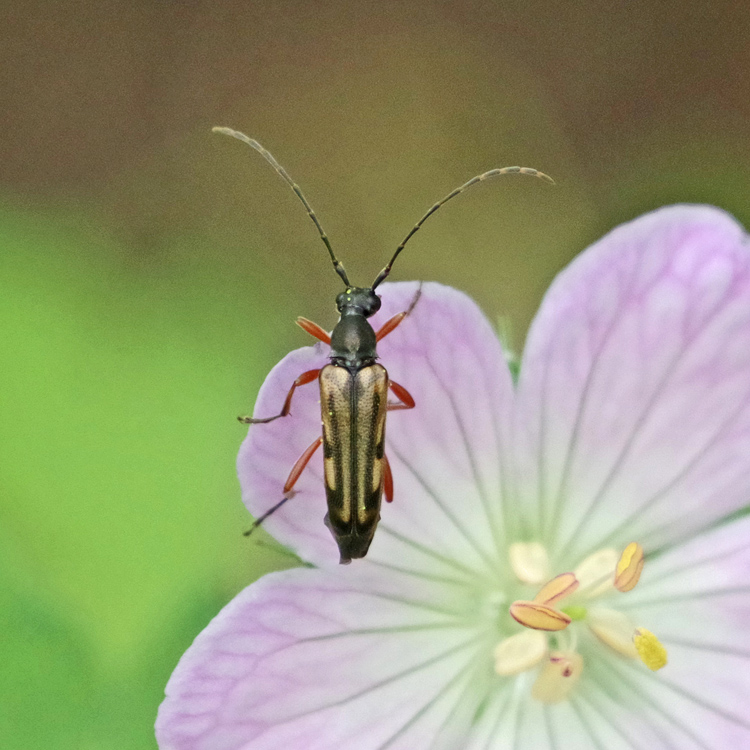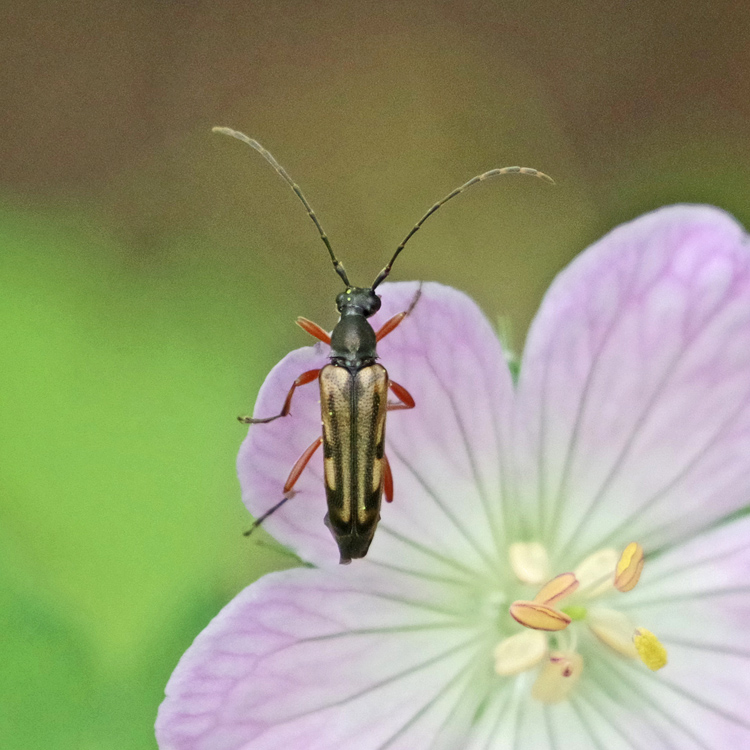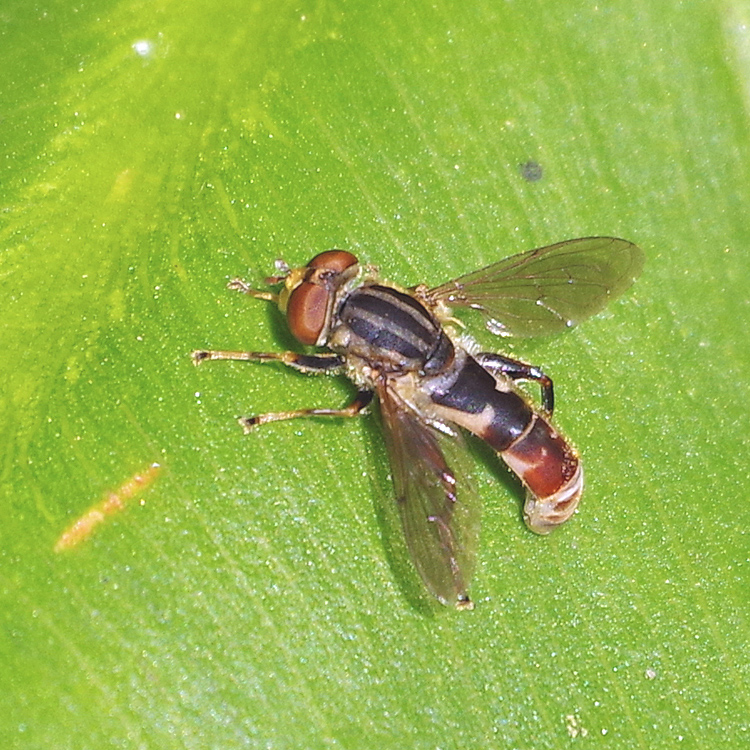
Bugs without Bios XVII
Greetings, BugFans,
The “Bugs without Bios” series features a bunch of lovely insects that need to hire a PR firm – they fly happily below the radar, and little is written about them.

EYED BAILEYA MOTH – Back at the beginning of June, while the BugLady was poking around the Ephemeral Pond at Riveredge, she spied this lovely (and, she thought, distinctive) moth. It took her a while to put a name with it. The Eyed Baileya (because of the small eyespots on the forewings) is in the family Nolidae, which was carved out of the Owlet moth family Noctuidae. It’s primarily an Old World family (named for Nola, Italy), and the 40 species that live in the New World represent about two percent of its total species. Nolids have hearing organs on the thorax, and they’re called tuft moths because many have tufts of raised scales on their forewings. Their caterpillars feed within webbed or folded leaves and overwinter in keeled, silk cocoons with a vertical slit for their eventual exit.
Eyed Baileya moths (Baileya ophthalmica) are found from the Great Plains to the Atlantic and north into Canada, in deciduous, often damp, woods and edges, where their caterpillars eat the leaves of hazel, American hornbeam, and hop hornbeam trees https://bugguide.net/node/view/936581/bgimage.
They come in a variety of shades of gray and brown, and they have a wingspan of about 1 ¼ inches. The subfamily Acontiinae in Owlet moth family are officially called the Bird Dropping moths https://bugguide.net/node/view/528934/bgimage; but other, unrelated moths, like this one, are referred to as (lower case) bird dropping moths because of their nifty camouflage. One of the Eyed Baileya moths’ field marks, a fuzzy thorax, is kind of worn on the BugLady’s moth https://bugguide.net/node/view/754045/bgimage.
They on the wing from early spring until mid-summer (in the north), and they have one or two broods here in God’s country. They overwinter inside a pupal case https://bugguide.net/node/view/1829824/bgimage that is inside a cocoon that they make by chewing strips of leaves and incorporating them into the cocoon wall https://bugguide.net/node/view/1769307/bgimage.

The ANALEPTURA LINEOLA BEETLE is a member of the charismatic Long-horned beetle family Cerambycidae, and it’s in the flower longhorn subfamily Lepturinae. True to their name, Flower longhorns are diurnal (day-flying) beetles that are often seen browsing for nectar on flower tops. They are long-legged, and they often appear wedge-shaped or “big-shouldered” – sometimes exaggeratedly so https://bugguide.net/node/view/524704/bgpage. There are about 200 species of flower longhorns north of the Rio Grande divided among about 60 genera; and Analeptura lineola is the only species in its genus.
Analeptura lineola (no common name) has an interesting range. It’s found from May through August over much of the eastern half of North America, well into Canada, but not, says bugguide.net, around the Gulf Coast. Wikipedia tells us that it is also found across Europe from France to Russia, and indeed, a good number of the hits that the BugLady got in her searches were in the “translate this page” category.
Their offspring lead an inconspicuous life, chewing tunnels (galleries) beneath the bark of dead or dying birch, ironwood, hornbeam and pine trees (they’re not considered pests). Their specialized intestinal flora (microbiome), reinforced by fungi ingested from the rotting wood, allows them to digest cellulose.
A dried specimen will cost you $3.00 on-line.

The awesomely-named LUMP-LEGGED SWAMP FLY(Anasimyia chrysostoma)is a syrphid-flower-hover fly in the family Syrphidae. Some British genus members are called Duck hoverflies and Duckflies (Anas is a genus of duck, and myia comes from a Greek word referring to the invasion of vital tissues). Their larvae are aquatic, so the adults are found around swamps, bogs, and other wetland edges, mostly in the northeastern quadrant of the continent. There are about six members of the genus in our area – the Moon-shaped, Two-lined, Smooth-legged, Short-spurred, Long-spurred, and the Lump-legged swamp fly (which comes by its name honestly https://bugguide.net/node/view/1911511/bgimage).
Adults hang around on flowers – especially fleabane, says one source (they’re great pollinators) – and the larvae are filter-feeders on organic debris in shallow, stagnant waters. They are among the “rat-tailed maggots” that breathe through a tube that extends from their rear to the water’s surface https://bugguide.net/node/view/815670.
The BugLady got into “translate this page” territory pretty fast with this one, too. In the 190 years since it was named and described, the Lump-legged Swamp fly has gone through at least five scientific names – Eristalis chrysostoma, Lejops relictus, Lejops chrysostomus, Helophilus relictus, and Anasimyia chrysostoma (as one source says, “the systematics of the family are in flux”), and it’s equally anonymous under all of them.
Fun Fact about the Lump-legged Swamp Fly: according to the Flower Flies of Minnesota, “Males are aggressively territorial and can sometimes be observed fighting.”
Kate Redmond, The BugLady
Bug of the Week archives:
http://uwm.edu/field-station/category/bug-of-the-week/
